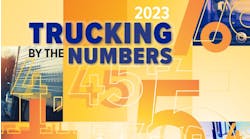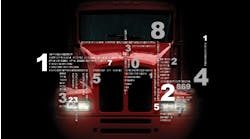Safety is everything to a fleet—it's a large part of its reputation and ability to do business, particularly in today's competitive freight environment. Fatal crashes involving heavy trucks and buses hit a low in 2009 but are up considerably since, revealing an unfortunate but logical truth: if the economy is thriving, there's more goods transportation and vehicles on the road, and a greater chance of collisions.
Studies by the U.S. Dept. of Transportation and others have repeatedly shown that in collisions with heavy trucks and passenger cars, the passenger vehicle is most often responsible—perhaps 75% of the time or higher. But the public's perception of those collisions tends to skew that fact, with the large commercial truck being bigger, heavier, and typically less damaged in such accidents.
Launch slideshow: Trucking by the Numbers 2018: Safety and the roadways
Still, according to the National Highway Traffic Safety Administration, the factor most often cited among heavy truck and bus drivers involved in fatal collisions is speeding. We rolled in a look at how frequently that appears as well as nine other top contributing factors in this Trucking by the Numbers section.
There's safety of a fleet or trucking company itself, but also generally in the areas where these organizations operate. Not all states are equal in that regard—some are more dangerous than others.
Just 10 states that generally follow some very heavily trafficked freight corridors are where more than half of the fatal crashes involving a heavy truck or bus take place. Half of the fatalities overall from those crashes occur there.
That list of states also closely—but not exactly—mirrors the states with the most congestion. Beyond the human cost of heavy truck collisions, there's a likelihood and frequency of collisions in general that can easily snarl a fleet's operations from day to day and hit drivers directly in the wallet.
Browse through this slideshow for a closer look at safety data on heavy trucks and buses, and where collisions and congestion pose the biggest challenges for trucking and goods transport.


